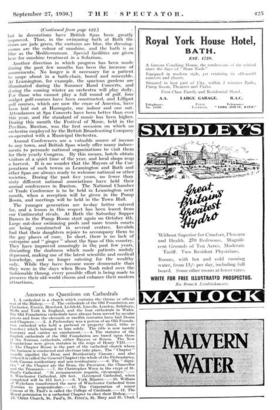Answers to Questions on Cathedrals
L A cathedral is a church which contains the throne or official
seat of the Bishop. 2. The cathedrals of the Old Foundation are Chiehester, Exeter, Hereford, Lichfield, Lincoln, London, Salisbury, Wells and York in England, and the four cathedrals in Wales. The Old Foundation cathedrals have always been served by secular priests and from the eleventh or twelfth centuries have had Deans and Chapters.-3. A Prebendary was a person of an Old Founda- tion cathedral who held a prebend or property (land, tithe or benefice) which belonged to him solely. The title is now merely honorary and carries no emolument.-4. The statutes of the English cathedrals of the Old Foundation are based upon those of the Norman cathedrals, either Bayeux or Rouen. The New Foundations were given statutes in the reign of Henry VIII.- +. The Chapter House is the part of the cathedral church where the business is conducted and elections take place. The " Chapter " usually signifies the Dean and Residentiary Canons ; and also (when it is called the General Chapter) the whole of the Prebendaries, both Canons residentiary and non-residentiary.-6. The " digni- ties" of the Chapter are the Dean, the Precentor, the Chancellor and the Treasurer.-7. Sir Christopher Wren in the crypt of St. Paul's Cathedral. " Si monumentum requiris, eircumspice."--- 8. Winchester Cathedral, 526 feet. (Liverpool Cathedral, when completed will be 611 feet. )-9. York Minster.-10. William of Wykeham transformed the nave of Winchester Cathedral from Norman to perpendicular.-11. The Corporation of minor Canons of St. Paul's is called the College of Cardinals.-12. The Royal permission to a cathedral Chapter to elect their Bishop.— 13. Christ Church,.at. Faure, St, Petcr:13, .St, Mary and St. Chad.


































 Previous page
Previous page